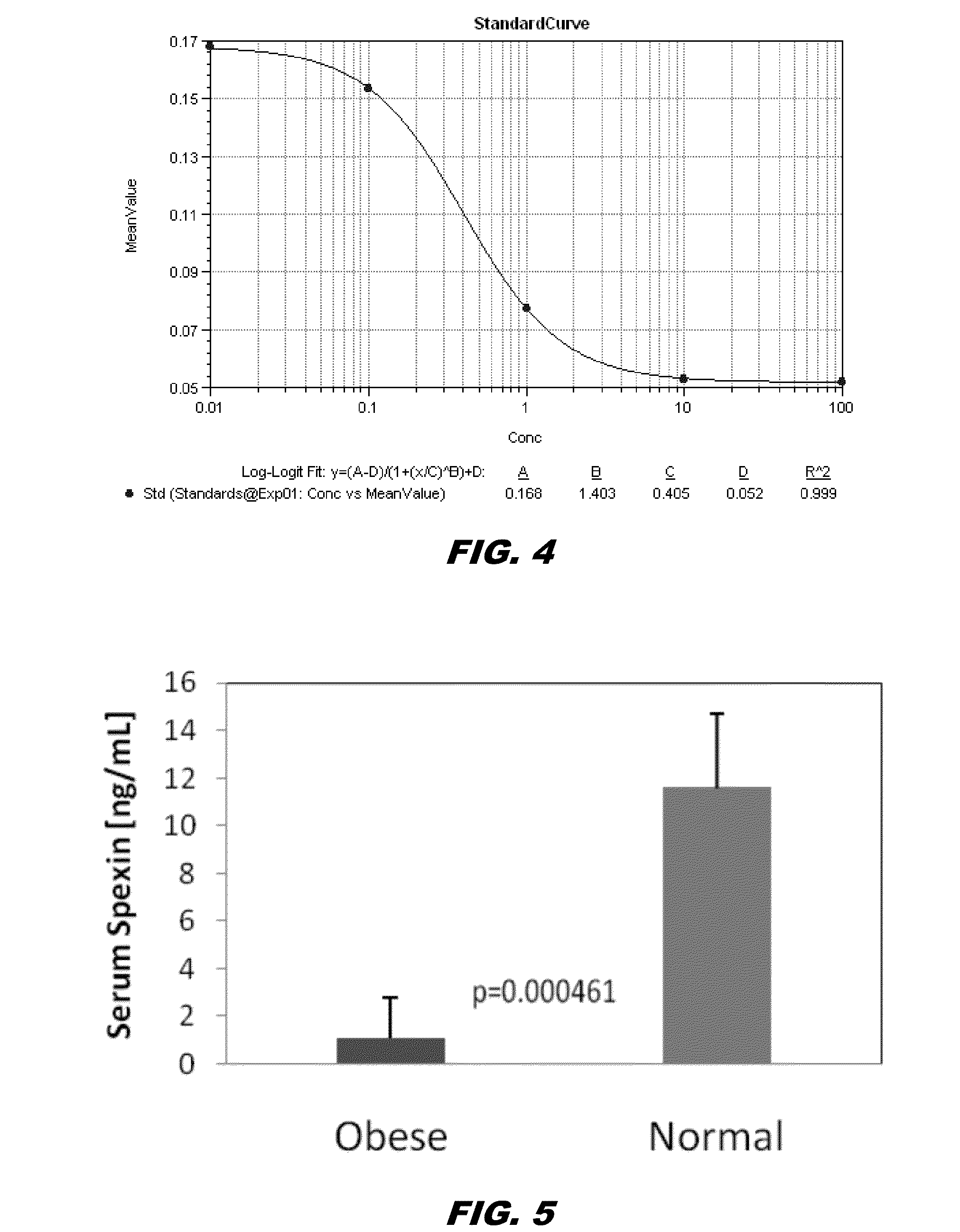Obesity-related genes and their proteins and uses thereof
a technology of obesity-related genes and proteins, applied in the field of obesity-related genes and their proteins, can solve the problems of significant increase in the risk of becoming obese, and achieve the effects of reducing adipose tissue mass, reducing serum leptin levels, and increasing serum spexin levels
- Summary
- Abstract
- Description
- Claims
- Application Information
AI Technical Summary
Benefits of technology
Problems solved by technology
Method used
Image
Examples
example 1
Identification of Spexin as a Potential Satiety Factor That is Approximately 15 Fold Underexpressed in Omental and Subcutaneous Fat in Obese Patients
[0170]Human and mouse models of obesity for serum levels of Spexin via radioimmunoassay (RIA) are being tested to see if circulating spexin levels correlate with tissue depot expression levels. Also, western blots of human tissues are being carried out to measure expression levels, and to determine molecular weights of expressed peptides. The genomic sequence and expressed mRNA of Spexin from human sources (both obese and normal) is being characterized to see if sequence variants (e.g., SNPs, insertions, deletions, etc) account for differential expression of Spexin, or if unknown splice variants of Spexin exist, that are not recognized by the probe on the Codelink arrays used in these studies.
[0171]Using whole genome microarray analysis of human fat samples from two different depots, gene expression levels between obese vs. normal weigh...
example 2
Spexin Expression in Obese and Normal Serum Samples
[0197]Example 1 discusses the significant under-expression of Spexin in omental and sub-cutaneous fat samples from obese patients. Therefore, it was decided to assay Spexin in serum samples from obese and normal weight patients, to see if the differences in obese fat gene expression resulted in significant differences in circulating Spexin levels. Leptin levels were also measured since Leptin is known to be a circulating adipokine that is elevated in the obese state. Without being bound by theory, circulating Spexin and Leptin can be “antagonistic” hormones / adipokines that are involved in the regulation of satiety, food intake, and body weight.
[0198]Serum Samples:
[0199]Serum samples from 7 obese and 7 normal weight human female patients were assayed in these initial studies.
[0200]Spexin Assay:
[0201]Circulating spexin levels in serum were assayed using the Spexin / NPQ (human, mouse, bovine) EIA kit from Phoenix Pharmaceuticals, Inc, C...
example 3
Spexin Infusion to Determine Role of Spexin in Satiety
[0211]Initial Dose-Determining Experiments.
[0212]Both normal weight and obese high-fat diet mice will be tested for circulating levels of Leptin, insulin, and Spexin. The Spexin level in human serum is approximately 10 ng / ml in normal subjects (e.g., non-obese subjects), thus the following four doses will be tested in the initial studies: about 3 ng, about 10 ng, about 30 ng, about 100 ng, about 1 mg, about 10 μg, and about 100 μg.
[0213]Pharmaceutical grade Spexin (a 14 amino acid peptide normally circulating in mice and humans) has been synthesized by conventional solid-state chemistry, and purified to >95% identity by Phoenix Pharmaceuticals (Burlingame, Calif.). This agent will be solubilized in 1× sterile saline (pH 7.4) at four different concentrations, so that doses of 1.5 μg / kg / QD, 5 μg / kg / / QD, 15 μg / kg / / QD, or 50 μg / kg / QD can be administered to 5 mice in each dose group. Final total doses of 3 μg / kg / day, 10 μg / kg / day, 30 ...
PUM
| Property | Measurement | Unit |
|---|---|---|
| concentration | aaaaa | aaaaa |
| body weight | aaaaa | aaaaa |
| weight | aaaaa | aaaaa |
Abstract
Description
Claims
Application Information
 Login to View More
Login to View More - R&D
- Intellectual Property
- Life Sciences
- Materials
- Tech Scout
- Unparalleled Data Quality
- Higher Quality Content
- 60% Fewer Hallucinations
Browse by: Latest US Patents, China's latest patents, Technical Efficacy Thesaurus, Application Domain, Technology Topic, Popular Technical Reports.
© 2025 PatSnap. All rights reserved.Legal|Privacy policy|Modern Slavery Act Transparency Statement|Sitemap|About US| Contact US: help@patsnap.com



